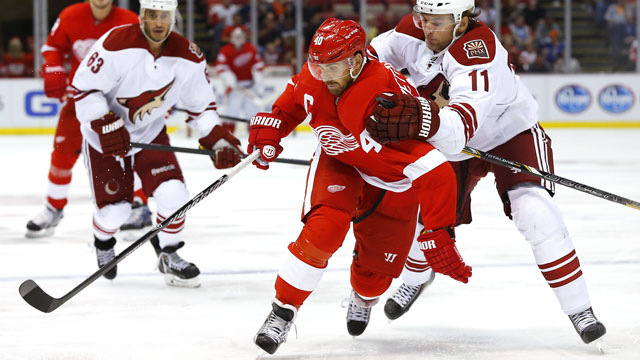People who follow hockey intuitively understand that there’s an element of chance in winning or losing.
If you sit down and watch the highlights from a busy night around the NHL, you’ll generally notice that there are a lot of close games; 68 per cent of last season’s contests were decided by two goals or fewer. Moreover, there are a lot of plays in which a fortunate bounce or a puck hitting a skate an inch to the left or right, results in a goal being scored — or not.
Scoring is a product of two things: the rate at which shots are taken and the rate at which they actually go in. People with an interest in hockey stats tend to measure this by looking at shot-attempts for (goals, shots on goal, missed shots and blocked shots) divided by total shot attempts.
This produces the oft-mocked but little understood Corsi% stat.
What these people have found is that the rates at which teams take shots or allow shots tend to sort themselves out pretty quickly—a team that takes 55 per cent of the five-on-five shot attempts over, say, 10 games, is probably really good at out-shooting the opposition. Last year, only New Jersey (25), Los Angeles (23), Chicago (18), Boston (11 times), Ottawa (11), Detroit (7), Montreal (7), Carolina (3), Dallas (3) Phoenix (2), Vancouver (2) and St. Louis (1) accomplished the feat.
Eight of those teams made the playoffs. So, if a team was good at outshooting the opposition over a 10-game span, we had a pretty good idea that it would be good in general over the course of a full season.
Fifty-five percent is a pretty phenomenal Corsi%. Hockey is a flow game—the puck goes up the ice and down the ice. Only two teams managed a full-season Corsi% of 55 percent or better last year—New Jersey and L.A.
At this point in the season, it’s simply too early to draw any type of conclusions beyond observing what has happened; at best, you’re looking for things that would be unusual for a good team or a bad team to do.
One of the great things about Corsi% is that it acquires meaning quickly, in that it’s unusual for a great team to struggle over a relatively small number of games or vice versa. Early in the season therefore, it’s the number to watch — because it tells us more than a team’s record, which is heavily tied to save percentage and shooting percentage and thus takes more time to sort out.
Five of last year’s top-10 Corsi% teams (Montreal, Detroit, Chicago, LA and Boston) are ahead of the pack again this season after the first week or so of play. Vancouver and San Jose, also in the top-10, were just outside of it last season, so it’s not too surprising to see them amongst the NHL’s elite early on.
That leaves Columbus, Dallas and Minnesota as newcomers to the Corsi% top-10, three teams who weren’t very good last season.
There’s not much data yet, but both Dallas and Columbus are under new management—general managers with ties to clubs that have been dominant possession-teams in the past (Jim Nill from Detroit and Jarmo Kekalainen from Ottawa, when the Senators were consistently outshooting the opposition) and it seems like they’re going to be interesting teams to follow.
Minnesota hasn’t just been an awful team to watch over the past six years, they’ve never posted a Corsi% that was north of 50 per cent. In all six years, opponents had more shot attempts at Minnesota’s goalies than the Wild generated. Through three games this year, they’re at 59.4 per cent. That number will fall, but it is an unusually good mark for a bad team to post over three games, so there might be reason for hope, Wild fans.
At the other end of the ledger, we see six teams that were also bottom-dwellers last season (Tampa Bay, Toronto, Philadelphia, Nashville, Calgary and Buffalo) and four newcomers: St. Louis, Winnipeg and both New York teams. The Blues will be fine — they’ve been a strong out-shooting team in the past. The Rangers are on an extended road trip that featured a meeting with San Jose, who — we’ve noted — have been dominant to date this year. It’s harder to find an excuse for the Jets and Islanders, though. Neither team has had a particularly difficult start.
All that said, even the numbers that gain meaning most quickly require a little time, and you can’t draw much in the way of conclusions after two or even four games.
Should Jets and Islanders fans be concerned? Some. Should Wild fans be hopeful? A bit.
But it’s best to keep expectations and fears in check for another week or so.


